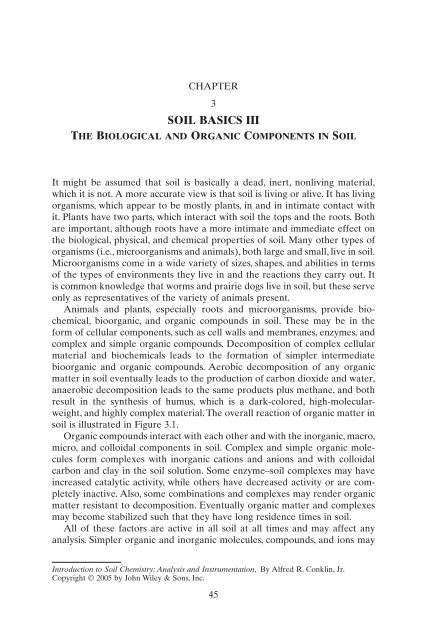Introduction to Soil Chemistry
Introduction to Soil Chemistry
Introduction to Soil Chemistry
Create successful ePaper yourself
Turn your PDF publications into a flip-book with our unique Google optimized e-Paper software.
CHAPTER<br />
3<br />
SOIL BASICS III<br />
THE BIOLOGICAL AND ORGANIC COMPONENTS IN SOIL<br />
It might be assumed that soil is basically a dead, inert, nonliving material,<br />
which it is not. A more accurate view is that soil is living or alive. It has living<br />
organisms, which appear <strong>to</strong> be mostly plants, in and in intimate contact with<br />
it. Plants have two parts, which interact with soil the <strong>to</strong>ps and the roots. Both<br />
are important, although roots have a more intimate and immediate effect on<br />
the biological, physical, and chemical properties of soil. Many other types of<br />
organisms (i.e., microorganisms and animals), both large and small, live in soil.<br />
Microorganisms come in a wide variety of sizes, shapes, and abilities in terms<br />
of the types of environments they live in and the reactions they carry out. It<br />
is common knowledge that worms and prairie dogs live in soil, but these serve<br />
only as representatives of the variety of animals present.<br />
Animals and plants, especially roots and microorganisms, provide biochemical,<br />
bioorganic, and organic compounds in soil. These may be in the<br />
form of cellular components, such as cell walls and membranes, enzymes, and<br />
complex and simple organic compounds. Decomposition of complex cellular<br />
material and biochemicals leads <strong>to</strong> the formation of simpler intermediate<br />
bioorganic and organic compounds. Aerobic decomposition of any organic<br />
matter in soil eventually leads <strong>to</strong> the production of carbon dioxide and water,<br />
anaerobic decomposition leads <strong>to</strong> the same products plus methane, and both<br />
result in the synthesis of humus, which is a dark-colored, high-molecularweight,<br />
and highly complex material. The overall reaction of organic matter in<br />
soil is illustrated in Figure 3.1.<br />
Organic compounds interact with each other and with the inorganic, macro,<br />
micro, and colloidal components in soil. Complex and simple organic molecules<br />
form complexes with inorganic cations and anions and with colloidal<br />
carbon and clay in the soil solution. Some enzyme–soil complexes may have<br />
increased catalytic activity, while others have decreased activity or are completely<br />
inactive. Also, some combinations and complexes may render organic<br />
matter resistant <strong>to</strong> decomposition. Eventually organic matter and complexes<br />
may become stabilized such that they have long residence times in soil.<br />
All of these fac<strong>to</strong>rs are active in all soil at all times and may affect any<br />
analysis. Simpler organic and inorganic molecules, compounds, and ions may<br />
<strong>Introduction</strong> <strong>to</strong> <strong>Soil</strong> <strong>Chemistry</strong>: Analysis and Instrumentation, By Alfred R. Conklin, Jr.<br />
Copyright © 2005 by John Wiley & Sons, Inc.<br />
45
















